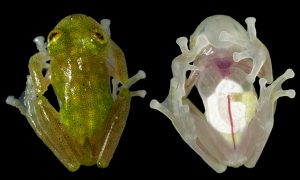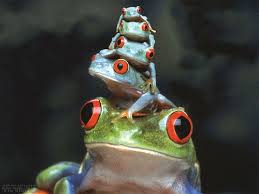Hyalinobatrachium taylori
The next animal that I have chosen to write about is an amphibian with the scientific name Hyalinobatrachium taylori. This is a species of frog that lives in South America, and some parts of mexico. They live around rivers in forests. They live at sea level to about 3,800 meters above. They hide in the vegetation around the rivers including trees. These frogs are nocturnal. They are active at night in order to find food and mate. The males have a certain call that they use when searching for a mate that gets louder when they are more dominant. The call is a short high pitched sound. The males will choose a calling site that is preferable for egg laying so that it is close to the water. Males are extremely territorial, and will sometimes physically fight over calling sites. When another male comes close the call will change to a deeper pitch. The defending male will jump onto the back of the approaching male, who will squirm out of the grasp and find another calling spot. When a female comes over to where the male is calling he will jump onto her back and initiate sexual advances. This lasts for a few hours, and the female will deposit about 20 eggs onto the chosen leaf. The leaf that is chosen will generally be over the river so that it can get water to run over the eggs, and so that when they hatch the larvae will fall into the water. It is hypothesized that the larvae will burrow into the bottom of the river and develop there. The males will then guard the eggs for the night. They may return the next and subsequent nights. During the day the frog will sleep hiding near the river in leaves. The frogs also eat during the night, and consume small insects. The frogs are light green with yellow, white, black, or blue spots. Their appearance is the most interesting aspect of these frogs, and also gives them their nickname of the glass frog. Their dorsal or back side that can be seen by looking down at them from their natural position is green and normal looking, but the ventral or underside is a much different story. The underside of these frogs is transparent, so that the internal organs are visible. This is hypothesized to help with camouflage, which is important for these small nocturnal animals that could be tasty meal for the more abundant species that are active during the day. For people who are against dissection, may also like these frogs since they can still be studied internally without harming the frogs, at least to an extent. Sadly these amazing frogs are also endangered. At least some of the species that fall under the family that make up glass frogs. This is due to habitat destruction through processes like deforestation, which leaves the frogs without a place to hide during the day.
References
Kubicki, B. (n.d.). Glass frog care and information. Retrieved October 4, 2016, from http://www.reptilesmagazine.com/Wild-Amphibians/Glass-Frog-Basics/
Nelson, J. K. (2006, June). Glass frog, hyalinobatrachium taylori. Retrieved October 4, 2016, from https://siteslab.byu.edu/Portals/25/images/Field/FrenchGuiana/GlassFrog_HyalinobatrachiumTaylori.JPG

